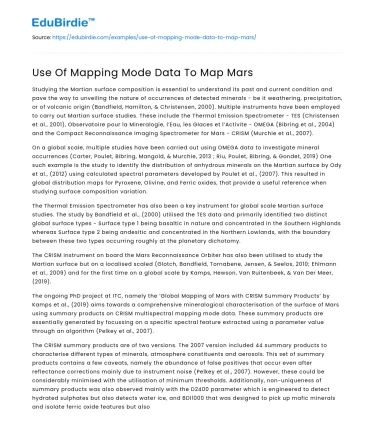Studying the Martian surface composition is essential to understand its past and current condition and pave the way to unveiling the nature of occurrences of detected minerals - be it weathering, precipitation, or of volcanic origin (Bandfield, Hamilton, & Christensen, 2000). Multiple instruments have been employed to carry out Martian surface studies. These include the Thermal Emission Spectrometer - TES (Christensen et al., 2001), Observatoire pour la Mineralogie, l’Eau, les Glaces et l’Activite - OMEGA (Bibring et al., 2004) and the Compact Reconnaissance Imaging Spectrometer for Mars - CRISM (Murchie et al., 2007).
On a global scale, multiple studies have been carried out using OMEGA data to investigate mineral occurrences (Carter, Poulet, Bibring, Mangold, & Murchie, 2013 ; Riu, Poulet, Bibring, & Gondet, 2019) One such example is the study to identify the distribution of anhydrous minerals on the Martian surface by Ody et al., (2012) using calculated spectral parameters developed by Poulet et al., (2007). This resulted in global distribution maps for Pyroxene, Olivine, and Ferric oxides, that provide a useful reference when studying surface composition variation.
The Thermal Emission Spectrometer has also been a key instrument for global scale Martian surface studies. The study by Bandfield et al., (2000) utilised the TES data and primarily identified two distinct global surface types - Surface type 1 being basaltic in nature and concentrated in the Southern Highlands whereas Surface type 2 being andesitic and concentrated in the Northern Lowlands, with the boundary between these two types occurring roughly at the planetary dichotomy.
The CRISM instrument on board the Mars Reconnaissance Orbiter has also been utilised to study the Martian surface but on a localised scaled (Glotch, Bandfield, Tornabene, Jensen, & Seelos, 2010; Ehlmann et al., 2009) and for the first time on a global scale by Kamps, Hewson, Van Ruitenbeek, & Van Der Meer, (2019).
The ongoing PhD project at ITC, namely the ‘Global Mapping of Mars with CRISM Summary Products’ by Kamps et al., (2019) aims towards a comprehensive mineralogical characterisation of the surface of Mars using summary products on CRISM multispectral mapping mode data. These summary products are essentially generated by focussing on a specific spectral feature extracted using a parameter value through an algorithm (Pelkey et al., 2007).
The CRISM summary products are of two versions. The 2007 version included 44 summary products to characterise different types of minerals, atmosphere constituents and aerosols. This set of summary products contains a few caveats, namely the abundance of false positives that occur even after reflectance corrections mainly due to instrument noise (Pelkey et al., 2007). However, these could be considerably minimised with the utilisation of minimum thresholds. Additionally, non-uniqueness of summary products was also observed mainly with the D2400 parameter which is engineered to detect hydrated sulphates but also detects water ice, and BDI1000 that was designed to pick up mafic minerals and isolate ferric oxide features but also ends up detecting glass and dust (Pelkey et al., 2007). This set of summary products was then updated by Viviano-Beck et al., (2014) using corrected spectral reflectance at certain wavelength positions of the CRISM in its target observation mode, to adequately map the heterogeneous nature of the Martian surface. This list also includes certain new summary products that have been derived to focus on recently acquired spectral information on new areas. These summary products have been vital in identifying various mineral occurrences over the surface of Mars, and these identified minerals along with their type locality (on Mars) have been compiled into a spectral library, that could be utilised for spectral studies as a reference, called the ‘Minerals Identified through CRISM Analysis’ (Seelos, Viviano, Ackiss, Kremer, & Murchie, 2019). Both the versions of the summary products have been employed by Kamps et al., (2019) to generate a global map as shown in Figure 1.
This research will stem from the previously mentioned ongoing study of Kamps et al., (2019) to investigate an apparent compositional variation in the Northern Lowlands of Mars, that has been spotted in the analysis of Kamps et al., (2019) (see Fig 1- Northern Transition Unit).






 Stuck on your essay?
Stuck on your essay?

